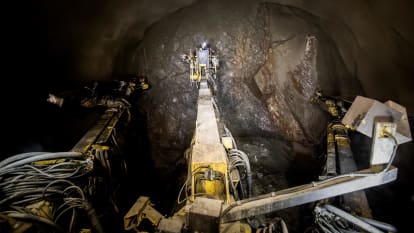Mælefjell tunnel, Telemark
In 2017, NCC completed the construction of a new tunnel on the E134 expressway between Gvammen and Århus in Telemark, Norway.
NCC was awarded the "E134 Gvammen-Århus, Main Contract K4" in 2014, and it involves establishing a new connecting road between Gvammen and Århus in Telemark. The new 11.7 km projected road comprises an above-ground road and a 9.4 km tunnel.
The E134 expressway is the shortest route from Drammen to Haugesund and is a main connecting road between Eastern and Western Norway. The standard of the road in Telemark is poor in many places with narrow sections, sharp bends and steep inclines. Sections of the road between Gvammen (Municipality of Hjartdal) and Århus (Municipality of Seljord) in particular present significant challenges for accessibility in the winter. Rerouting the road through a tunnel from Gvammen to Århus will shorten the E134 by about 11 km. In addition, the new road will be almost flat, which will also reduce driving time for heavy vehicles by about 18 minutes.
Construction of the tunnel alone will generate more than 1.2 million m3 of rock that is to be blasted. The tunnel is to have a C classification and a T10.5 cross section including three rock caverns. The rock is largely comprised of quartzite and most of the tunnel will be covered with a depth of rock in excess of 1,000 m, which will entail extensive rock stresses and the possibility of spalling of rock. The tunnel will be excavated from two sides. The plan is to cover about 245,000 m² of the tunnel walls in shotcrete and about 4,200 m² in wall elements.
The material on the Gvammen side comprises heavy deposits of sand and gravel partially made up of rock. The upper one to two meters comprise relatively uniform sand. There is a layer of peat and gravel with a high organic material content from a depth of 3-18 m. The organic material acts as a sealing layer between an upper and lower groundwater aquifer, which is under artesian pressure. Due to the differences in pressure, it is very important that this sealing layer is not perforated and this means that, for example, piles cannot be used for the foundations of the bridges at Gvammen. As a result, lightweight material fill was used north of the channel.
The road is also constructed as low as possible in the terrain to reduce the extent of settling. Preloading followed by reviews to assess settlement is expected to provide control of settlement in the road and provide a basis for optimizing the bridge foundations. The road and areas for the bridge foundations at Gvammen must be preloaded for at least one year before construction can begin. Most of the preload material will be removed before construction of the bridge foundation and road begins.
The 2.6 km main road to be built under the contract will have an S4 dimension classification. In addition, three concrete brides, two arch bridges, two tunnel portals, 12 technical sites, footbridges and 2.5 km of local roads will be built. Under the contract, about 40,000 m of drainage/surface water pipes, 350 tanks, 170,000 m of cables and about 58,300 tons of asphalt will be built/laid. The project will also be model-based.
The project will follow NCC's proprietary "Green Construction Site" concept during construction, which imposes stricter requirements than those dictated by the authorities regarding, for example, energy consumption and waste management.
